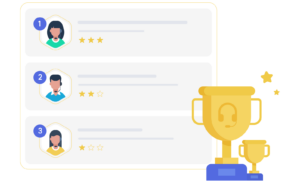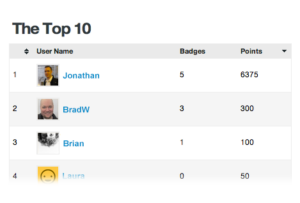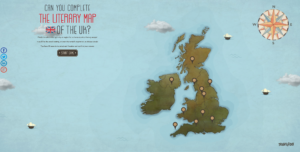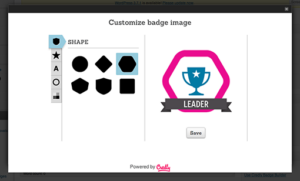Have you ever taken a placement quiz on a website to determine which Internet package was right for you? Have you completely filled in your LinkedIn profile to get rid of the accomplishment bar at the top? Have you found something unexpected on a website that caused you to spend more time browsing? If you answered yes to any of the above questions, you’ve experienced elements of “gamification” in web design.
What is Gamification?
Gamification is the act of taking a process that already exists (say, filling out a social media profile) and applying game mechanics to make it more engaging. Some examples of game mechanics frequently used in website gamification include:
- Points and Achievement – Usesf positive reinforcement that allows website users to set goals, earn badges, and “level up” or gain some sort of elevated status.
- Rules of Play – games typically have set rules of play, including fast feedback (i.e. a star for a correct answer, or a slight change in color for a completed answer, etc.).
- Competition/ Status – Competition between other users or to get a personal high score, is also a common aspect of gamification. Often, winning will confer some sort of elevated status on users (i.e. a top tier loyalty customer, etc.).
- Self-expression – Social aspects or collaboration could also be considered aspects of gamification – a message board, for example, could be gamified.

You may be thinking, “my business is too serious for a silly game!” However, that’s not what we mean by “gamification”. Gamification is about increasing engagement for an existing process. You could use it for everything from encouraging customers to return to your site to onboarding new employees in a fun way that will stick with them.
Why Do People Use Gamification in Websites?
Gamification can have many examples for websites, including higher levels of adoption (for loyalty programs, for example), conversion increases, or decreases in time spent onboarding clients or employees. In fact, even just one element of interactivity on your site can encourage a deeper level of attention and participation from website users because users intrigued by one element of a site are more likely to search for more engaging content.
According to the Peak-End rule in modern psychology, content that sparks moments of joy or discovery, however brief, is much more memorable than other types of content. Gamification can spark these peaks – with something relatively simple like visual storytelling with minimal interactions (like on a marketing website for your complex product set) to a full-on competition with a leaderboard and diverse levels (like on a language learning website).

Gamification Guidelines
While gamification can be a great way to add interest and interactivity to your site, it also can increase the levels of expectation that users have for your site content and overall business. Here are some guidelines to consider when considering gamification in your web design:
- Make it more than just a fun add on: Gamification methods can’t just be an add on. They must resonate with your business mission and strategy. Otherwise, they will take away from your site and business message.
- Include a way out: Ensure your game elements don’t block users from engaging in other ways with your site. You should use gamified elements to enhance engagement, but make sure you have other options for those who might not want to play or who might be looking for information about you and your products faster.
- Follow logic and keep it simple: Knowing basic psychology is important when adding game elements to a site. If these elements don’t make sense to users, the point of gamification is lost. In addition, you need to keep things simple. Remember, you’re not creating an entire game, just using aspects of games to accomplish a business goal. Sudden realizations (sparks of discovery) are better in progression – you shouldn’t expect your users to learn or retain too many things at once.
Gamification Ideas for Your Business
Everyone’s business is different and will have different possible ways to include gamification in their site. Here are a few for different types of businesses:
- Quiz Mechanics: A quiz or game to figure out which of your products or packages is right for the user. This can teach the user more about what you do and the differences between your packages in a fun way that will be memorable.
- Real-world example: TravelZoo’s literary map of the UK (to generate buzz for the different cities on the map)
- Social Mechanics: A competition that displays rankings of different users so that more users complete reviews, order more, or come back to use your site or resource more often. A message board on your company website can also be implemented so that users can share good (and bad) experiences with friends and family.
- Real-world examples: Citroen’s on-screen test to get users to scroll as fast as they can (to associate Citroen with speed and enjoyment)
- Problem Solving: You provide users the tools they need to solve a problem that you pose to them. With more information, users receive more content and more control of the process. (To set up Vive’s VR headset, the company put a game on their site – upon completion of which, the headset will be ready).
- Accomplishment and Completion: You encourage users to complete a task that is already halfway done by dangling an accomplishment. (LinkedIn uses a status bar when you’re filling out your profile to encourage you to fill it out more fully and to share on the platform with others).

BadgeOS
A great gamification WordPress plugin that we recommend our clients to consider is BadgeOS. BadgeOS is a fully customizable add-on, allowing you to define an unlimited number of types and customize them as much as you like. Utilizing BadgeOS, company’s can design their own badges, define required steps to achieving specific badges, track achievements via a leaderboard, allow users to share achievements via social media, and so much more.

We Won’t Play Games with Your Site – But We Can Gamify It
Want to explore gamification and its possibilities for your site, but don’t know where to start? We can help! Bluetext has a wealth of experience in creating engaging and successful sites, including gamification, from visual storytelling to quizzes, to choose-your-own-adventure experiences. We won’t play games with your site, but you can bet that we can gamify it.